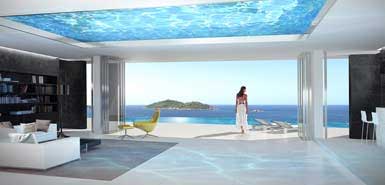


THE HUNT for a status home has taken buyers many places - but the most determined are now eyeing a slice of distant Gondwanaland. That ancient super-continent sheared apart 100 million years ago, leaving Africa, South America, Antarctica and
The expense and inconvenience of traveling to the islands has long rendered them a once-in-a-lifetime experience for conventional travelers (and notoriously surly service ensured that those who risked coming hesitated to embark on the adventure again). But the otherworldly appeal of the islands - 115 of them, some granite-based, others coral atolls, and a significant number barely inhabited - have proved irresistible to the discerning European super-rich, who might be inclined to find the South of France or the Spanish costas too crowded and too dull.
Three years ago the Seychelles Government - with just tourism and tuna fishing to sustain living standards of its 84,000 multicultural Seychellois - took note of the mood in other far-flung beauty spots such as Mauritius and Thailand and opened up property ownership to foreigners. But the care that is demanded of developers and the challenge of securing ownership of land means that the first schemes are only now coming on to the market.
The competition is intense. James Davies, a director of Hamptons International, which is to market Four Seasons villas, priced from £3.34million, says: “We have had interest from a royal family, Middle Eastern high net-worth individuals, a European financier, a couple of entrepreneurs who have sold big businesses and a well-known fashion designer. The buyers will typically have numerous homes around the world but are attracted by the fact that even their contemporaries may not be able to buy.”
Make no mistake: this may be a kind of low-tax location and an outpost of prime
These prevailing shortages - which seem not to trouble the contented souls who make the islands their home - have not discouraged the likes of Bill Gates, Liz Hurley and Prince William from holidaying here. But the promise of plenty has contributed to the interest in the Four Seasons and other developments. Davies says that the 28 villas under construction, which are set on the southwest coast of the relatively populous main island, Mahé, will offer “all the benefits that people in that income bracket need. Four Seasons can provide a chef, or a butler, or rent out your villa while you are not there. And there will be no nosy neighbours or paparazzi.” The flagship resort with spa, set around characteristic rocky hillsides, has wide verandahs with a colonial feel. The understated rooflines and traditional granite cladding allow the villas (which share the 96 pools on site and have as many as six bedrooms and a lift) to blend in among the palms and albizia trees.
The more style-conscious of these buyers will not care to be dictated to, even by as formidable a brand as Four Seasons. Tucked away near the secondary islands of Praslin and La Digue, is Félicité, a perfectly formed private island given over for the most part to lush jungle and great sheets of black granite for the rest. Until now the island, which overlooks the snorkeling haven of Ile Cocos, has been given over to a dated resort (which Tony Blair reputedly enjoyed), but work will soon commence on the construction of Zil Pasyon - 28 arresting villas, “surgically placed” among the sheets of rock.
The designer is the
The development is an early foray into residences by the spa company Per Aquum, best known for Huvafen Fushi, an elite development featuring 43 bungalows on a private island in the
A rival spa company, Dhevatara, best known in
Very sad. I spent 3 years in the 1970s working for the Seychelles Government. We lived on Mahe’s southwest coast in one of the few modest bungalows that had been completed in a thankfully failed holiday development. My children (both under 10) roamed safely over the beach and hillsides, I traveled to work on a camion (an open lorry roughly fitted out as a bus), my wife often caught our supper off the end of a breakwater... It was peaceful, unspoiled, slow, and an overwhelmingly Seychellois area--few tourists, no extremes of wealth and poverty. To its credit, the then government refused to be browbeaten by the financial advisers of rich and sometimes famous foreigners (a Beatle among them) eager to develop exclusive hotels.
Now the multi-millionaires are coming, fleeing from contact with all but their own kind, indifferent to local culture--and to local people, except as a service class. It is not only the ‘wide verandahs’ that will remind the Seychellois of their colonial past.
Ken Affleck,